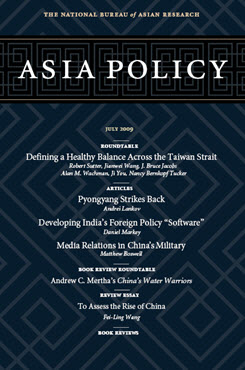Media Relations in China's Military
The Case of the Ministry of National Defense Information Office
This article overviews the available information on China’s Ministry of National Defense Information Office (MNDIO), a media relations organ established in 2008 to serve the People’s Liberation Army (PLA), and explores possible motivations behind the office’s creation.
EXECUTIVE SUMMARY
This article overviews the available information on China’s Ministry of National Defense Information Office (MNDIO), a media relations organ established in 2008 to serve the People’s Liberation Army (PLA), and explores possible motivations behind the office’s creation.
MAIN ARGUMENT
The development of a spokesperson and press office for the PLA appears to reflect a realization by the Chinese defense establishment that in today’s highly mediated environment, conspicuous silence on matters of public interest is no longer a viable public relations strategy. In this context, the MNDIO can be understood in two ways: (1) as a mechanism through which the PLA can more clearly and effectively interface with the outside world and (2) as means for the PLA to generate a favorable public consensus on issues of strategic or political concern. Countering negative perceptions and promoting the image of a capable, responsible, and transparent military has become an important task for the PLA. The MNDIO advances this cause by serving as a vehicle to project centrally approved messages about the PLA and its actions, thereby allowing the PLA to more effectively tell its own story.
POLICY IMPLICATIONS
- The creation of the MNDIO is a small step in China’s progress in engaging the international community and improving military transparency. Insofar as the office represents conformity to international norms by improving access to reliable, timely, and authoritative information regarding PLA activities and policy positions, the U.S. should welcome the MNDIO.
- The MNDIO’s apparent role in managing public opinion in the service of political and strategic ends is more problematic. Institutional mechanisms in China already limit the ways in which public debate on Beijing’s strategic choices can deviate from centrally formulated orthodoxy. Furthering the reach and power of such mechanisms warrants concern because the resulting deficit of informed, rational public debate increases the possibility of miscalculation or escalation in the event of crisis or confrontation involving the U.S.
- Although the MNDIO currently appears to be a relatively inchoate project, the U.S. should be prepared for increasingly sophisticated PLA efforts to engage the domestic and international media in the future.
About Asia Policy
Asia Policy is a peer-reviewed scholarly journal presenting policy-relevant academic research on the Asia-Pacific that draws clear and concise conclusions useful to today’s policymakers. Asia Policy is published quarterly in January, April, July, and October and accepts submissions on a rolling basis. Learn more


